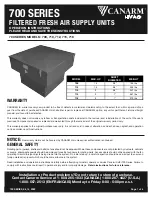
© Munters AB, 2013
12
3.1 Delivery check
Upon receipt, inspect the fan for external damage and if found, inform the forwarding agent without delay. Check
the data on all the rating plates, especially voltage and frequency. Turn propeller by hand to check free rotation.
Check the opening of the shutter by hand.
3.2 Packaging and transport of assembled fans
The fan has a self-supporting structure in galvanised steel and it is usually delivered withpackaging. Fans should not
be permanently stocked one upon the other, regardless if they are delivered with or without packaging. Handling
of the fans should not be done manually as the fans have no handles or grips. Consequently one of the following
alternatives should be used:
•
trolley: when loading the fan on the trolley make sure fan shutter is positioned outwards;
•
forklift: before loading, make sure the forks are opened as much as possible to avoid bending of the fan
bottom panel and damaging the shutter;
•
crane: fix two bolts in the M8 bushes situated on the sides of the fan housing and hook the lifting cable over
the bolts
3.3 Structure
The fans consist of the following components:
•
fan housing in zinc magnesium galvanized steel steel without welding spots;
•
propeller with three blades in stainless or zinc magnesium galvanised steel; blades are fixed to the propeller
by high-strength pop rivets;
•
asynchronous three-phases motor; 50 or 60 Hz; B3 form; F class winding insulation, IP55 protection class;
single-speed.
Make sure a steel cable or rope of adequate size is being used when the fan is
lifted by crane. Fan weights are shown in the technical specification table
(see
section 7.1)
.
Warning
Before using
3.













































